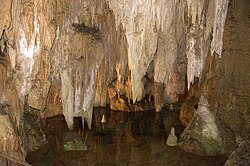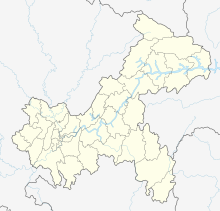Furong Cave
| Furong Cave 芙蓉洞 | |
|---|---|
 Stalactites in the Furong Cave | |
| Location | Wulong District, Chongqing |
| Length | 2.846 km (1.768 mi) |
| Official name | Part of the South China Karst |
| Reference | 1248-007 |
| Inscription | 2006 (30th Session) |
| Coordinates | 29°13′10″N 107°54′35″E / 29.219574°N 107.909782°E |
Furong Cave (Chinese: 芙蓉洞) is a karst cave located on the banks of the Furong River, 20 km (12 mi) from the seat of Wulong District, Chongqing, People's Republic of China.[1]
History
First discovered by local farmers in 1993 the cave was opened to tourists in 1994. It became a national 4A tourist site in 2002 then in June 2006 part of the South China Karst UNESCO World Heritage Site ; the only cave in China on the UNESCO list.[2]
In 1994, 1996 and 2001, cave experts from countries including China, the UK, USA, Ireland and Australia undertook comprehensive explorations of the cave.[3]
Description
Furong Cave has a total length of 2,846 m (9,337 ft) and a width varying from 30 m (98 ft)–50 m (160 ft). Inside, the cave is divided into three sections, with the first featuring colorful subterranean features. The remaining two areas focus on the science of cave formation. There are more than 30 features inside the cave including the 15.76 m (51.7 ft), 21.04 m (69.0 ft) stone waterfall (巨型石) at the foot of which coral-like projections extend to 120 cm (47 in).[4]
In the vicinity of the cave spread over a total area of around 20 km2 (7.7 sq mi), there are more than 50 vertical shafts with a depth of over 100 m (330 ft). including the 920 m (3,020 ft) deep Steam Shaft (汽坑洞), the deepest in Asia.[citation needed]
Formed during the Cambrian/Ordovician Periods some 500 million years ago,[2] the cave features numerous rarely found speleothems including coral and dog-tooth like crystalline calcite flowers as well as a variety of helictites, and crystalline gypsum flowers.[5]
See also
References
- ^ 芙蓉洞 [Furong Cave] (in Simplified Chinese). Xinhua. October 12, 2005. Retrieved February 16, 2011.
- ^ a b "Furong Cave". Retrieved February 14, 2011.[permanent dead link]
- ^ 神秘梦境 芙蓉洞 [Mysterious Dreamscape - Furong Cave] (in Simplified Chinese). Xinhua. December 6, 2005. Archived from the original on July 18, 2011. Retrieved February 15, 2011.
- ^ 芙蓉洞 [Furong Cave] (in Simplified Chinese). June 4, 2006. Retrieved February 15, 2011.
- ^ "Furong Cave". Karst Dynamics Laboratory, Guangxi Normal University, PRC. Archived from the original on October 6, 2014. Retrieved February 14, 2011.
External links
- (in English)—China Radio International: "Furong Cave, Chongqing"
- Cam111.com: Furong Cave — photos gallery

